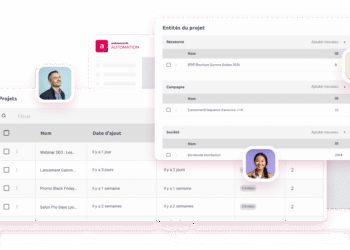What are the benefits of email marketing to you? If you’re interested in email marketing and looking for some statistics, I have put together this list of email marketing ROI statistics.
Email marketing is famous for having a high ROI, and has been consistent for years. So find out why email is widely considered the most effective marketing channel to date.
What is the ROI of email marketing?
A high ROI (Return on Investment) shows that you get a lot of “bang for your buck”. And that is great. Because every time you spend money on your business, it’s meant to move the needle. You want to see investments pay off and add to the bottom line.
Relatively low investments/costs that lead to high returns. Return on Investment (ROI) is a popular performance metric that compares the revenue returns with the money and time invested.
Here are the most important Email Marketing ROI Statistics.
Key Email Marketing ROI Statistics
- The average ROI for marketing emails in the US and UK is between 3600% and 3800%.
- Nearly 1 in 5 companies achieve email marketing ROI of 7000% or more. That’s $70 for every $1 spent.
- 52% of marketers saw email marketing ROI double in 2023 compared to the previous year.
- Automated workflows generate 30x higher returns compared to one-off email campaigns.
- 41% of marketers say email is their most effective channel, way ahead of social media and paid search (16%).
- Email is the most effective channel for driving sales. 52% of consumers made a purchase directly from an email they received.
- The average value of a customer email address in the UK is £36.64.
- Automotive gets the highest revenues per email recipient of any industry. Standard campaigns in automotive get $0.16 per recipient, while automations return $5.47 on average.
- Ecommerce emailers get an average annual revenue of $6.86 per subscriber.
What is the Average ROI for Email Marketing?
Return on Investment (ROI) is a popular performance metric comparing revenue returns with the money and time invested. So what does the average ROI look like for email?
- For every $1 spent on email marketing, businesses see a return of $36.
That’s an email marketing ROI of 3600%. Email marketing is such a powerful channel for a reason, it has a higher ROI than any other channel. Some industries are doing better than average like Retail, eCommerce and Consumer Goods which have the highest email ROI of any sector (4500%).
- The average email marketing ROI for large businesses is 44:1.
4400% ROI is an even bigger number than the average. The general trend is that bigger is better. With a bigger list, you can use the scalability of email marketing. Email scales like crazy, the cost per extra email sent is tiny, and so the ratio becomes more and more attractive as lists and the number of customers grow.
- The average ROI for email marketing campaigns is 3800% or $38 for every $1 spent.
This number comes from the DMA in the UK. Where the email marketing ROI increased from 30:1 to 38:1 in five years.
- 18% of companies report an email marketing ROI greater than 7000%.
- 63% of organisations that get a high ROI from email marketing spend more than 20% of their marketing budget on it. Spending more on email marketing pays off. Conversely, 75% of companies that report low ROI spend less than 20% of their marketing budget on email campaigns.

- We saw an average ecommerce ROI of $72 per $1 spent on email marketing in the US.
That’s a 7200% return. The ecommerce software provider Omnisend shared the ROI of their US users.
- 42% of B2B companies don’t see email marketing returns reach $36 per $1 spent. On the flipside, 21% get an ROI above $40 per $1 invested.
- 52% of marketers said email marketing ROI doubled in 2023 compared to the previous year. In the same survey, 5.7% saw a 4x increase in returns.

- Automated workflows generate 30x higher returns compared to one-off email campaigns. According to Klaviyo, the average return per recipient (RPR) for email campaigns is $0.11. Automated flows earn $1.94 per recipient on average. But for abandoned cart flows, that increases to $3.65.
- The top 10% of email automations by performance earn $16.96 per recipient. That compares to $0.95 for the top email campaigns. Abandoned cart workflows are again the highest earners with a top 10% RPR of $28.89. Welcome flows offer the second-best returns, with an average RPR of $2.65 and top 10% returns of $21.18 per recipient.

- A/B testing can increase email marketing ROI by 83%. Businesses that never A/B test report an average ROI of 2300%, versus 4200% for those that often A/B test. You can find 170 email A/B testing ideas if you don’t know where to start.
- Testing emails against spam filters raises ROI by 39%. Testing the appearance of marketing emails in different browsers, desktops and mobile devices gives an 18% uplift.
- The ‘sweet spot’ for sending frequency is 9-16 emails a month, which gives an average ROI of 4600%. And what’s the best time to send your newsletter, you might ask? When your subscriber is ready to buy.

- Using dynamic content for personalized email marketing campaigns raises ROI by 258%. Brands that never or rarely include dynamic content see an average ROI of 1200%. This compares to 4300% for businesses that often or always create personalized emails. Learn how to brief AI to generate new content that’s totally personalized from my guide about generative personlization.
- 65% of marketers use personalized subject lines on more than half of their emails.
Does email marketing have the highest ROI?
Yes, email marketing has the highest ROI of any marketing channel. With a side note that comparing ROI across marketing channels is a challenge. Your own marketing approach impacts your business in multiple ways. For example, organic SEO’s benefits are long-term and build gradually over time. But PPC advertising is all about quick conversions and driving sales. You’re not comparing apples to apples.
This is exactly what email marketing ROI tells you. It’s the monetary return you get for what you spend.
- Every email marketing strategy is helped by tracking revenue, costs and ROI. Set it as a Key Performance Indicator (KPI), and make it your goal to improve performance over time.
- ROI allows you to compare marketing investments in campaigns, channels, and industry averages. That’s why it’s helpful to know your email marketing statistics.
- When you can demonstrate strong returns, it’s a great way to justify marketing spend.
We cover a lot of statistics here – and so there are lots of figures. So in some instances, email isn’t the best for everyone. But in most analyses, it’s at least competitive with other marketing channels. And by some estimates, it beats all other channels for ROI many times over. Plus, businesses and marketers rate email marketing highly for its effectiveness.
Here are some stats that back that up.
- 41% of marketers say email is their most effective channel. This puts email a long way ahead of both social media and paid search in joint second (both 16%). In a study from Litmus, the email channel is the most effective.

- 25% of marketers rate email as their top-performing channel. This beats organic search (19.7%) in second.

- 14% of global marketers said email marketing gave them the best ROI in 2024. 16% said websites, blogs & SEO. 16% also said social media shopping tools. 14% identified paid-for social content and content marketing as offering the best returns.

- The average ROI for SEO in the three years to Q3 2024 was 825%.
- Google estimates that for every $1 a business spends on Google Ads, they get $8 back in profit. Or an ROI of 800%.
- Average RPR for email campaigns ($0.11) is marginally lower than for SMS ($0.12). However, the top 10% of email campaigns outperform the best SMS, with respective RPRs of $0.95 and $0.77.
- 52% of consumers made a purchase directly from an email they received. This makes email the most effective channel for driving sales. It beats social media posts by 13% and social media ads by 11%.
- 59% of B2B marketers rate email as their most effective channel for prospecting. This is more than the number who rate PPC, SEO and organic social media as the best combined.
Email Marketing ROI Statistics by Industry

- Retail, eCommerce and Consumer Goods have the highest email ROI of any sector (4500%). Marketing, PR and Advertising also beat the average (4200%). Software and Technology (3600%) is in line with the average. But Media, Publishing & Events have a below-average ROI of 3200%.
- Campaigns in the food & beverage and automotive sectors earn $0.16 per recipient. These are the joint highest figures of any ecommerce sector. Hardware and home improvement is narrowly behind with an RPR of $0.14.
- The top-performing 10% of campaigns in electronics ecommerce earn $1.36 per recipient. This is the highest figure of any sector. And also the biggest gap between top-performing campaigns and average RPR ($0.10).
- Email automations earn an average of $5.47 per recipient in the automotive sector. But the hardware and home improvement sector has the highest top 10% revenues ($39.31 per recipient). Find more interesting stats about automation in my ultimate marketing automation statistics overview.

- Abandoned cart flows in the automotive sector earn $9.86 per recipient on average. That’s the highest average RPR of any automation flow type in any sector. The top 10% of abandoned cart flows in hardware and home improvement earn a massive $75.66 per recipient.
- Toys & Hobbies has the highest average click rate for email campaigns (1.81%). The top 10% of Toys & Hobbies campaigns get a click rate of 6.53%. This is also the highest figure of any sector.

- For automation flows, Sporting Goods has the highest average click rates (6.22%). But the top 10% of Toys and Hobbies automation see a click-through rate of 6.17%, the highest figure of any sector.
- Food and beverage has the highest rates of orders per email. On average, 0.18% of food and beverage campaign emails lead to an order. And 1.81% of automated emails.
How do you Calculate Email Marketing ROI?
ROI is calculated in a standard way as follows:
- Subtract costs from revenue to work out profit.
- Divide profit by costs. The answer tells you how much you make per unit of currency spent.
- Multiply your answer by 100 to turn your return figure into a percentage.
This can be written as a formula like this:

Measuring email marketing ROI isn’t always as straightforward as it may seem. The issue is to get the revenue and cost figures very clear and decide on what the attribution is for you.
There are obvious costs, like your email marketing software subscription. And whatever you pay per email sent. But email marketing also involves lead generation and growing your lists. What is the cost per new contact? How much time does your marketing team spend on email marketing? How do you break down their cost?
Calculating revenue from marketing emails is also a bit tricky. Because not all email marketing is directly focused on sales. Plenty of businesses send promotional emails to drive sales. Or things like abandoned cart emails to avoid lost purchases. It’s simple to attribute sales to these, the same way you do with ads.
But that doesn’t apply to informational newsletters, onboarding emails, or reactivation emails. A lot of the time, email marketing is focused on nurturing and brand building. It has benefits beyond immediate sales. That makes it tricky to calculate all revenue from email marketing. So ROI may be higher than you’d first think.
According to Litmus, only 12.5% of companies feel they are measuring email ROI adequately.1 And 36% aren’t measuring ROI for email marketing at all.2
Contrast this with paid channels. With something like pay-per-click (PPC) advertising, this is seemingly easy. You pay every time someone clicks on your ad. So costs are clear. And you can track sales revenue back to ads. And get a ROAS (Return on Ad spend).
Nowadays, many email marketers are looking at ROI, but also beyond ROI. They’re judging email’s value in terms of its wider contribution to customer journeys and lifecycles. Say you want to calculate the value of a specific nurture campaign. If you know your customer lifetime value (CLV). And you know the contribution email makes to different lifecycle stages. You can evaluate and compare the impact with other marketing channels.
The attraction of ROI is that it’s a straightforward way to demonstrate value. So email marketers have also found workarounds for calculating revenue. One is to use other email performance metrics. Things like open rates, click rates and conversion rates. And then use benchmark revenue values to estimate earnings.
That’s how this email marketing ROI calculator works. It calculates expected conversions from known email volumes, click rates and conversion rates. And then uses a value per conversion benchmark to estimate revenue.
Top Email Marketing ROI Metrics To Monitor
So working out email marketing ROI takes more than straightforward sales attribution. And using sales and revenue attribution alone would seriously underestimate email’s value anyway.

As the graphic above shows, marketers measure email performance in many different ways. Understanding email ROI is a case of piecing insights together to gain a bigger picture of email’s value.
So what are the best email metrics to use for calculating ROI?
Email-generated sales and revenue metrics
Revenue is the cleanest if you want to make ROI calculations. To talk about ROI, you have to ultimately come back to money.
There are several money-focused metrics you can use to measure email ROI. The simplest is email-generated sales. This makes life easy when you can directly attribute a sale to an email or a campaign. You just add up all the earnings from email-generated sales. And put that straight into the ROI calculation.
Customer Lifetime Value (CLV) and Revenue per Recipient (RPR)
Another way to break down known earnings from emails is revenue per recipient. This metric has been popularized in retention marketing. It doesn’t put the focus on the number of emails sent. Or the number of conversions. But on the number of email users who receive it.
This ties in with the trend of linking email value to the wider customer lifecycle. Many marketers are now thinking of email ROI in similar terms to customer lifetime value (CLV).
See here the calculation of Customer Lifetime Value for Email.
So not just the ROI of individual campaigns. But how email helps to nurture relationships and increase CLV. We’re seeing metrics like revenue per contact and revenue per email address emerge to reflect that.
Open and Click Attribution
Open and click are mainstays of email marketing metrics. Even though they aren’t completely reliable with auto-opens and auto-clicks. They’re easy to measure.
Marketers typically use these to evaluate engagement levels. Open rates tell you how much awareness you’re getting from your campaigns. And how good your subject line is. Click rates tell you how much interest that awareness creates. People clicking through to your landing pages is a sure sign of interest.
For attributing sales and ROI, we can use opens or clicks to attribute (part of) the sale to the email channel. Even if the sale isn’t coming directly from the email, but is done later on. The timespan between open/click and purchase is called the attribution window, setting a stricter attribution window makes sure that you aren’t attributing too much to the email channel.
The level of interest emails generate is useful when considering ROI. As marketers, you know that higher sales volumes don’t just come from more traffic. What you really want is traffic from leads with a high intention to buy. So strong interest is a good indicator of strong sales. That’s why a lot of marketers like click-to-open rates. A high number of clicks versus opens suggests people are interested in your campaigns. They’re motivated to act on what they see. And that drives sales.
Website Traffic
Creating traffic for your website is a goal of email marketing. That’s why click-through rate is a key performance metric. But it doesn’t give you any context or comparison with other marketing channels. You might get clicks from one in five emails sent out as part of a successful campaign. But how does that impact overall traffic volumes? And how does it compare to other channels?
Measuring web traffic lets you break down where clicks have come from. That’s useful for judging the value of email compared to other channels. You can also compare traffic before and after you send a campaign to see how it has impacted web visits.
Conversion Rates
In marketing, a conversion means someone taking an action you desire. So a recipient clicking a link in an email counts as a conversion. But there are other ways emails can ‘convert’. You can count sign-ups and registrations for a service or event. Or downloading a resource. Or leaving a review or rating. Or, of course, making a purchase.
In sales, conversion rate means something different. It’s how many leads you ‘convert’ into paying customers. Both types of conversion rates are useful for judging email ROI. If you know a general conversion rate per number of web visits, you can apply that to email-generated traffic only. And if you have an average value per sale, you can use that to estimate the value of email conversions. Find out how to increase your email conversion rate step-by-step.
Email Marketing Stats by KPIs
1. 34% of email marketers measure campaigns using both click-through and click-to-open rates.
2. 5.31% of automated email workflows lead to a click. This compares to 1.47% of non-automated campaigns. The top 10% of automated flows get an average click rate of 12.98%.
3. The average click-to-open rate across email marketing is 13.02%. That figure has slipped from a peak of 20.53% in 2020. Open rates, however, have been increasing, from 41.85% in 2019 to 48.69%.
4. 39.42% of opened ‘Email my cart’ emails lead to a click. That’s double the click-to-open rate of abandoned cart emails (19.60%).
5. 83.63% of welcome emails sent via GetResponse are opened. That leads to a click-through rate of 16.60% and click-to-open rate of 19.85%.
6. Campaigns sent to smaller lists with under 500 contacts get the best click-to-open rates (14.72%). The same is true of single-email automations (28.52%). Find out how to get smart with email segmentation and closer to the elusive “segment of one”
7. 14% of web traffic comes from email. This is narrowly behind social media (16%) and organic search (17%). But more than display ads (12%) and paid search (9%). The biggest source of traffic is still people typing in URLs (22%).
8. 38% of companies use conversion rate as a metric to calculate email ROI.
9. 15.22% of click-throughs from email convert. The overall conversion rate for all emails sent is 1.06%.
10. 41% of best-in-class email marketers use conversion rate as their primary KPI.
11. 24% of businesses say sales is the primary objective behind email marketing. 48% use sales as a key metric for measuring success.
12. The average value of a customer email address in the UK is £36.64.
13. Online vendors using Omnisend in the US get an average annual revenue of $6.86 per subscribed account.
I’ll leave you with the best conclusion:
“Brands try to hate email marketing, but their bank account never allows it.” – Jordie van Rijn
For more share-worthy quotes, check out the Hall of Fame of email marketing quotes.
Sources
What is the Average ROI for Email Marketing?
1. Litmus, The ROI of Email Marketing (2022)
2-3. Data & Marketing Association, Marketer Email Tracker (2021)
4-5. Data & Marketing Association, Marketer Email Tracker (2020)
6. Data & Marketing Association, Investigating Email: Getting Returns On Email (2020)
7. Omnisend, Email, SMS, and push marketing statistics for ecommerce (2023)
8. ViB, Factsheet: Are The Marketing And Sales Myths All Lies!? (2024)
9. Mailmodo, The State of Email Report (2024)
10-11. Klaviyo, The 2024 Benchmark Report (2024)
12-15. Litmus, The CMOs Guide to Email ROI (2023)
16. Mailmodo, The State of Email Report (2024)
Does Email Marketing Have the Highest ROI?
1. Litmus, The 2023 State of Email Report (2023)
2. Mailmodo, The State of Email Report (2024)
3. Hubspot, The State of Marketing (2024)
4. FirstPageSage, SEO ROI Statistics (2024)
5. Google, Economic Impact Methodology (2023)
6. Klaviyo, The 2024 Benchmark Report (2024)
7. Marigold, 2023 Consumer Trends Index (2023)
8. Sopro, The State of Prospecting (2023)
Email Marketing ROI Statistics by Industry
1. Litmus, The ROI of Email Marketing (2022)
2-8. Klaviyo, The 2024 Benchmark Report (2024)
How do you Calculate Email Marketing ROI?
1. Litmus, The CMOs Guide to Email ROI (2023)
2. Litmus, The 2023 State of Email Report (2023)
Top Email Marketing ROI Metrics To Monitor
1. Data & Marketing Association, Marketer Email Tracker (2021)
2. Klaviyo, The 2024 Benchmark Report (2024)
3-4. Barilliance, Email Marketing ROI Statistics: Open Rate to Revenue (2023)
5-6. GetResponse, 2024 Email Marketing Benchmarks (2024)
7. Hubspot, Web Traffic & Analytics Report [New Data] (2023)
8. Data & Marketing Association, Marketer Email Tracker (2021)
9. Barilliance, Email Marketing ROI Statistics: Open Rate to Revenue (2023)
10. Mailjet, Inbox Insights (2022)
11-12. Data & Marketing Association, Marketer Email Tracker (2021)
13. Omnisend, Email, SMS, and push marketing statistics for ecommerce (2023)


















